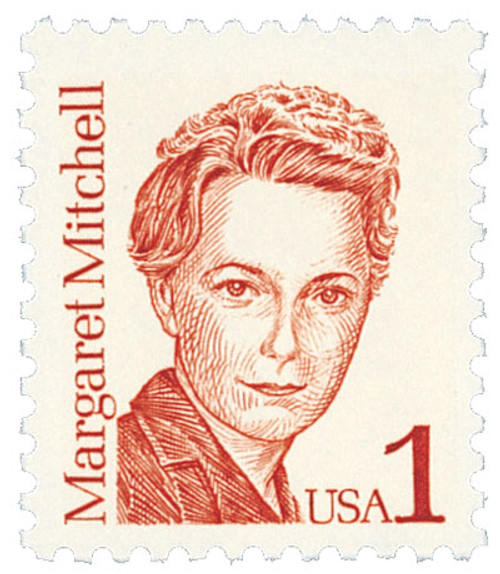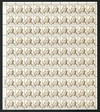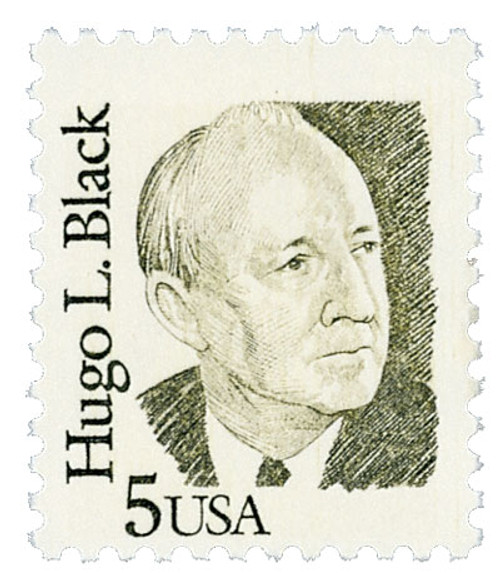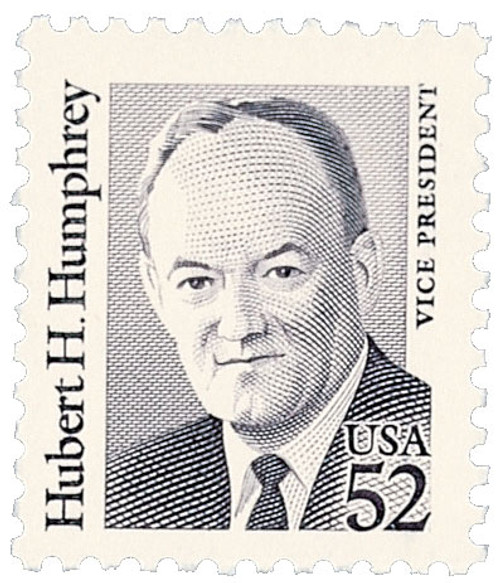
# 1851 - 1985 8c Great Americans: Henry Knox
U.S. #1851
1985 8¢ Henry Knox
Great Americans
- 24th stamp in Great Americans Series
- Stamp marked 200th anniversary of Knox’s appointment as first US secretary of war
- Knox participated in most of the major battles of the Revolutionary War
Stamp Category: Definitive
Series: Great Americans
Value: 8¢; for “make-up” postage
First Day of Issue: July 25, 1985
First Day City: Thomaston, Maine
Quantity Issued: 60,950,000
Printed by: Bureau of Engraving & Printing
Printing Method: Engraved
Format: Panes of 100
Perforations: 11
Color: Olive black
Why the stamp was issued: The stamp’s 8¢ value met no specific rate, but was intended for “make-up” postage. The stamp’s issue also coincided with the 200th anniversary of Henry Knox being appointed America’s first secretary of war.
About the stamp design: This was the first stamp design for artist Arthur Lidov. He based his stamp portrait on an oil painting provided by the Smithsonian’s National Portrait Gallery.
First Day City: The First Day ceremony for this stamp was held in Thomaston, Maine, near the Montpelier estate to which Knox retired in 1794.
About the Great Americans Series: The Great Americans Series was created to replace the Americana Series. The new series would be characterized by a standard definitive size, simple design, and monochromatic colors.
This simple design included a portrait, “USA,” the denomination, the person’s name, and in some cases, their occupation or reason for recognition. The first stamp in the new series was issued on December 27, 1980. It honored Sequoyah and fulfilled the new international postcard rate that would go into effect in January 1981.
The Great Americans Series would honor a wider range of people than the previous Prominent Americans and Liberty Series. While those series mainly honored presidents and politicians, the Great Americans Series featured people from many fields and ethnicities. They were individuals who were leaders in education, the military, literature, the arts, and human and civil rights. Plus, while the previous series only honored a few women, the Great Americans featured 15 women. This was also the first definitive series to honor Native Americans, with five stamps.
The Bureau of Engraving and Printing (BEP) produced most of the stamps, but private firms printed some. Several stamps saw multiple printings. The result was many different varieties, with tagging being the key to understanding them. Though there were also differences in perforations, gum, paper, and ink color.
The final stamp in the series was issued on July 17, 1999, honoring Justin S. Morrill. Spanning 20 years, the Great Americans was the longest-running US definitive series. It was also the largest series of face-different stamps, with a total of 63.
Click here for all the individual stamps and click here for the complete series.
History the stamp represents: Henry Knox was born on July 25, 1750, in Boston, Massachusetts. He was George Washington’s right-hand man during the American Revolution and participated in most of the war’s major battles.
After his father abandoned the family, Henry, the family’s oldest son, left school and took a job as a clerk in a bookstore. The shop’s owner, Nicholas Bowes, became a father figure to Knox. But Knox was also caught up in Boston’s street gangs, becoming one of his neighborhood’s best fighters. Then, one day he witnessed an impressive military demonstration and decided to join his local artillery company at age 18.
In 1770, Knox witnessed the Boston Massacre. The following year, he opened his own bookshop, the London Book Store. Having had little education as a child, Knox used his store to teach himself a number of things. He soon developed a deep interest in military history, reading everything he could find about military subjects.
In 1772, he cofounded the Boston Grenadier Corps, which he served as second in command. During this time, Knox supported the actions of the Sons of Liberty. While it’s unknown if he participated in the Boston Tea Party, he did serve as a guard for one of the ships, ensuring the tea wasn’t unloaded before the uprising.
Knox married Lucy Flucker in 1774, the daughter of Boston Loyalists who attempted to get Knox on their side. When the Battles of Lexington and Concord broke out the following year, Knox and his wife snuck out of Boston. Knox then joined the local militia in besieging the city. His bookshop was looted and all the stock was either destroyed or stolen. Working under General Artemas Ward, Knox developed fortifications for the city and then oversaw the artillery fire at the Battle of Bunker Hill.
General George Washington arrived in July 1775 to assume command of the army and was impressed by Knox’s work. The two men became good friends and worked together to develop the Continental Army. Knox hadn’t received an official military commission, but John Adams convinced the Second Continental Congress to appoint him a colonel in the army’s artillery regiment.
While Boston was still under siege, Knox had an idea. If they could get the cannons from recently captured Forts Ticonderoga and Crown Point to Boston, they could turn the tide of the battle. Washington supported his idea and sent him on the mission, which became known as Knox’s “noble train of artillery.” Knox and a team of engineers transported 60 tons of artillery from Northern New York to Boston in the middle of winter. One historian called the move, “one of the most stupendous feats of logistics” of the war. With those cannons in place, Washington forced the British to surrender the city.
As Washington’s right-hand man, Knox joined the commander-in-chief on most of his campaigns and was involved in most of the war’s major battles. He was nearly captured after the British invaded Manhattan. In December 1776, Knox directed the Christmas night crossing of the Delaware River that preceded the Battle of Trenton. He then oversaw the return of those men and hundreds of prisoners. For his efforts, Knox was promoted to brigadier general and given command of five artillery regiments.
That winter, Knox went back to Massachusetts to improve the manufacture of artillery and raise another battalion. He went on to participate in the battles at Brandywine, Germantown, and Monmouth before forming the army’s first artillery and officer training school which is often considered the precursor to West Point. He then joined in the Siege of Yorktown, where he directed artillery. In 1782, Knox became the army’s youngest major general and was tasked with negotiating prisoner exchanges with the British, which ultimately failed. When Washington stepped down in 1783, Knox took over as the senior commander of the Army. He formed the Society of the Cincinnati, a fraternity of Revolutionary War officers, and developed plans for a peacetime army.
Knox was considered for the post of secretary at War, but when Congress tried to create a standing militia as a peacetime army, he resigned. Knox returned to Massachusetts and settled in present-day Maine. In 1785, Knox was appointed secretary at War. The War Department was small but Knox was authorized to raise a 700-man army. When Shays’s Rebellion broke out in 1786, it made the weaknesses of the military and the Articles of Confederation obvious, leading to the Constitutional Convention. Knox sent George Washington a proposal for a new government, similar to what was eventually adopted. He also encouraged Washington to attend the convention, calling him the “Father of Your Country,” possibly one of the first instances of this phrase being applied to Washington.
Knox promoted the new constitution and under it was made the first secretary of War of the new War Department. In this role, Knox was responsible for maintaining and managing the Army and the Navy, until the Navy Department was established in 1798. He also saw that new coastal fortifications were established, demanded better training of the local militias, and settled disputes in the western part of the infant nation.
Knox retired from government work in January 1795 to spend more time with his family. In his final years, he embarked on a number of business ventures including real estate, cattle farming, shipbuilding, and brick making. In 1806, Knox swallowed a chicken bone which caught in his throat and became infected. Three days later, on October 25, 1806, he died and was later buried with full military honors.
Numerous sites have been named after Knox, including the city of Knoxville, Tennessee. Counties in nine states have been named in his honor, and two military forts were also named for him.
U.S. #1851
1985 8¢ Henry Knox
Great Americans
- 24th stamp in Great Americans Series
- Stamp marked 200th anniversary of Knox’s appointment as first US secretary of war
- Knox participated in most of the major battles of the Revolutionary War
Stamp Category: Definitive
Series: Great Americans
Value: 8¢; for “make-up” postage
First Day of Issue: July 25, 1985
First Day City: Thomaston, Maine
Quantity Issued: 60,950,000
Printed by: Bureau of Engraving & Printing
Printing Method: Engraved
Format: Panes of 100
Perforations: 11
Color: Olive black
Why the stamp was issued: The stamp’s 8¢ value met no specific rate, but was intended for “make-up” postage. The stamp’s issue also coincided with the 200th anniversary of Henry Knox being appointed America’s first secretary of war.
About the stamp design: This was the first stamp design for artist Arthur Lidov. He based his stamp portrait on an oil painting provided by the Smithsonian’s National Portrait Gallery.
First Day City: The First Day ceremony for this stamp was held in Thomaston, Maine, near the Montpelier estate to which Knox retired in 1794.
About the Great Americans Series: The Great Americans Series was created to replace the Americana Series. The new series would be characterized by a standard definitive size, simple design, and monochromatic colors.
This simple design included a portrait, “USA,” the denomination, the person’s name, and in some cases, their occupation or reason for recognition. The first stamp in the new series was issued on December 27, 1980. It honored Sequoyah and fulfilled the new international postcard rate that would go into effect in January 1981.
The Great Americans Series would honor a wider range of people than the previous Prominent Americans and Liberty Series. While those series mainly honored presidents and politicians, the Great Americans Series featured people from many fields and ethnicities. They were individuals who were leaders in education, the military, literature, the arts, and human and civil rights. Plus, while the previous series only honored a few women, the Great Americans featured 15 women. This was also the first definitive series to honor Native Americans, with five stamps.
The Bureau of Engraving and Printing (BEP) produced most of the stamps, but private firms printed some. Several stamps saw multiple printings. The result was many different varieties, with tagging being the key to understanding them. Though there were also differences in perforations, gum, paper, and ink color.
The final stamp in the series was issued on July 17, 1999, honoring Justin S. Morrill. Spanning 20 years, the Great Americans was the longest-running US definitive series. It was also the largest series of face-different stamps, with a total of 63.
Click here for all the individual stamps and click here for the complete series.
History the stamp represents: Henry Knox was born on July 25, 1750, in Boston, Massachusetts. He was George Washington’s right-hand man during the American Revolution and participated in most of the war’s major battles.
After his father abandoned the family, Henry, the family’s oldest son, left school and took a job as a clerk in a bookstore. The shop’s owner, Nicholas Bowes, became a father figure to Knox. But Knox was also caught up in Boston’s street gangs, becoming one of his neighborhood’s best fighters. Then, one day he witnessed an impressive military demonstration and decided to join his local artillery company at age 18.
In 1770, Knox witnessed the Boston Massacre. The following year, he opened his own bookshop, the London Book Store. Having had little education as a child, Knox used his store to teach himself a number of things. He soon developed a deep interest in military history, reading everything he could find about military subjects.
In 1772, he cofounded the Boston Grenadier Corps, which he served as second in command. During this time, Knox supported the actions of the Sons of Liberty. While it’s unknown if he participated in the Boston Tea Party, he did serve as a guard for one of the ships, ensuring the tea wasn’t unloaded before the uprising.
Knox married Lucy Flucker in 1774, the daughter of Boston Loyalists who attempted to get Knox on their side. When the Battles of Lexington and Concord broke out the following year, Knox and his wife snuck out of Boston. Knox then joined the local militia in besieging the city. His bookshop was looted and all the stock was either destroyed or stolen. Working under General Artemas Ward, Knox developed fortifications for the city and then oversaw the artillery fire at the Battle of Bunker Hill.
General George Washington arrived in July 1775 to assume command of the army and was impressed by Knox’s work. The two men became good friends and worked together to develop the Continental Army. Knox hadn’t received an official military commission, but John Adams convinced the Second Continental Congress to appoint him a colonel in the army’s artillery regiment.
While Boston was still under siege, Knox had an idea. If they could get the cannons from recently captured Forts Ticonderoga and Crown Point to Boston, they could turn the tide of the battle. Washington supported his idea and sent him on the mission, which became known as Knox’s “noble train of artillery.” Knox and a team of engineers transported 60 tons of artillery from Northern New York to Boston in the middle of winter. One historian called the move, “one of the most stupendous feats of logistics” of the war. With those cannons in place, Washington forced the British to surrender the city.
As Washington’s right-hand man, Knox joined the commander-in-chief on most of his campaigns and was involved in most of the war’s major battles. He was nearly captured after the British invaded Manhattan. In December 1776, Knox directed the Christmas night crossing of the Delaware River that preceded the Battle of Trenton. He then oversaw the return of those men and hundreds of prisoners. For his efforts, Knox was promoted to brigadier general and given command of five artillery regiments.
That winter, Knox went back to Massachusetts to improve the manufacture of artillery and raise another battalion. He went on to participate in the battles at Brandywine, Germantown, and Monmouth before forming the army’s first artillery and officer training school which is often considered the precursor to West Point. He then joined in the Siege of Yorktown, where he directed artillery. In 1782, Knox became the army’s youngest major general and was tasked with negotiating prisoner exchanges with the British, which ultimately failed. When Washington stepped down in 1783, Knox took over as the senior commander of the Army. He formed the Society of the Cincinnati, a fraternity of Revolutionary War officers, and developed plans for a peacetime army.
Knox was considered for the post of secretary at War, but when Congress tried to create a standing militia as a peacetime army, he resigned. Knox returned to Massachusetts and settled in present-day Maine. In 1785, Knox was appointed secretary at War. The War Department was small but Knox was authorized to raise a 700-man army. When Shays’s Rebellion broke out in 1786, it made the weaknesses of the military and the Articles of Confederation obvious, leading to the Constitutional Convention. Knox sent George Washington a proposal for a new government, similar to what was eventually adopted. He also encouraged Washington to attend the convention, calling him the “Father of Your Country,” possibly one of the first instances of this phrase being applied to Washington.
Knox promoted the new constitution and under it was made the first secretary of War of the new War Department. In this role, Knox was responsible for maintaining and managing the Army and the Navy, until the Navy Department was established in 1798. He also saw that new coastal fortifications were established, demanded better training of the local militias, and settled disputes in the western part of the infant nation.
Knox retired from government work in January 1795 to spend more time with his family. In his final years, he embarked on a number of business ventures including real estate, cattle farming, shipbuilding, and brick making. In 1806, Knox swallowed a chicken bone which caught in his throat and became infected. Three days later, on October 25, 1806, he died and was later buried with full military honors.
Numerous sites have been named after Knox, including the city of Knoxville, Tennessee. Counties in nine states have been named in his honor, and two military forts were also named for him.



















